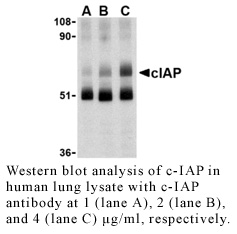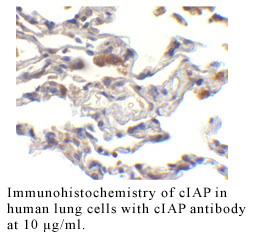Anti-Human cIAP (CT)
Data
- -
- -
Antibody DetailsProduct DetailsReactive Species Human Host Species Rabbit Immunogen PN:C1288 Product Concentration 1.0 mg/ml Formulation This polyclonal antibody is formulated in phosphate buffered saline (PBS) pH 7.4 containing 0.02% sodium azide as a preservative. Storage and Handling This polyclonal antibody is stable for at least one week when stored at 2-8°C. For long term storage, aliquot in working volumes without diluting and store at –20°C in a manual defrost freezer. Avoid Repeated Freeze Thaw Cycles. Country of Origin USA Shipping Next Day Ambient RRIDAB_2828395 Each investigator should determine their own optimal working dilution for specific applications. See directions on lot specific datasheets, as information may periodically change. DescriptionDescriptionSpecificity Rabbit Anti-Human cIAP recognizes an epitope near the C-terminus of mouse and human c-IAP. The antibody detects both c-IAP1 and c-IAP2. This polyclonal antibody was purified using affinity chromatography. Background Apoptosis, or programmed cell death, is related to many diseases, such as cancer. Apoptosis is triggered by a variety of stimuli including members in the TNF family and can be prevented by the inhibitor of apoptosis (IAP) proteins. IAP proteins form a conserved gene family that binds to and inhibits cell death proteases.1 The two isoforms of c-IAP (c-IAP1 and c-IAP2) are structurally related to XIAP, containing 3 baculoviral IAP repeat (BIR) motifs that are essential and sufficient for the binding and inhibition of caspases–3, –7.2,3 The c-IAPs can associate with the death receptor TNF-R2, and mediate the ubiquitinization of TRAF2 following the binding of TNF-α by its receptor.2,4 Omi, a negative regulator of c-IAP, inhibits its activity by catalytically cleaving c-IAP.5 Another negative regulator, Smac/DIABLO, acts by enhancing the auto-ubiquitization activity of c-IAP.6 PubMed References & Citations1. Schimmer, AD. (2004) Cancer Res. 64:7183-90. 2. Goeddel, D. et al. (1995) Cell 83:1243-52. 3. Reed, JC. et al. (1998) EMBO J. 17:2215-23. < br> 4. Ashwell, JD. et al. (2002) Nature 416:345-7. Technical ProtocolsCertificate of Analysis |




